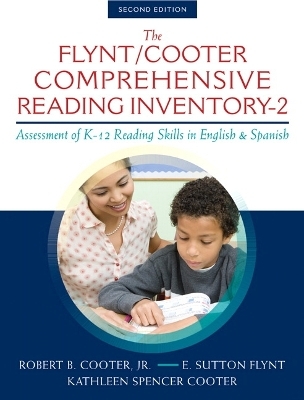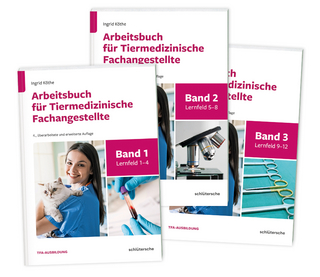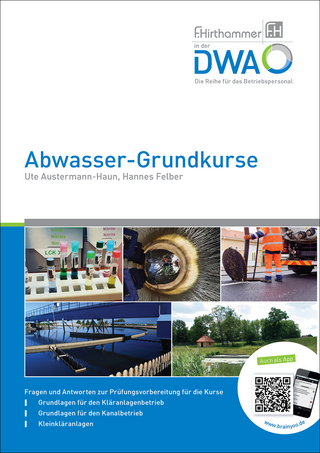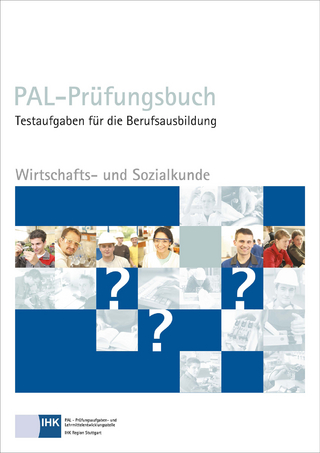
Flynt/Cooter Comprehensive Reading Inventory, The
Pearson (Verlag)
978-0-13-336252-7 (ISBN)
- Titel z.Zt. nicht lieferbar
- Versandkostenfrei innerhalb Deutschlands
- Auch auf Rechnung
- Verfügbarkeit in der Filiale vor Ort prüfen
- Artikel merken
Robert B. Cooter, Jr. currently serves as Dean of the Annsley Frazier Thornton School of Education and Ursuline Endowed Chair of Teacher Education at Bellarmine University in Louisville, Kentucky. Author of numerous books and articles on reading instruction, his primary research focuses on the improvement of literacy instruction for children living at the poverty level. From 2006—2011 Cooter was co-editor of The Reading Teacher, the world’s largest circulation refereed journal for literacy educators (International Reading Association). Dr. Cooter previously served as the first “Reading Czar” (associate superintendent) for the Dallas Independent School District (TX). In 2007, he and colleagues J. Helen Perkins and Kathleen Spencer Cooter received the national Urban Impact Award from the Council of Great City Schools. His latest work involves the implementation of a new Ph.D. program at Bellarmine University focused on developing “change agents” interested in improving education outcomes for children living in poverty circumstances. E. Sutton Flynt currently serves as Professor of Literacy Education and Director of Teacher Education at the University of Memphis. Dr. Flynt has almost 40 years of teaching experience as a classroom teacher in the public schools, university professor, university department chairperson, and dean of a college of education. He has consulted with school districts in eight different states and served on state departments of education task forces in Louisiana, Kansas, and Tennessee. Dr. Flynt has numerous professional publications in his areas of interest primarily focusing on literacy assessment, pre-service teacher preparation, and content area reading instruction. In 2007—2008 he coauthored a featured column on content literacy in The Reading Teacher. He has frequently presented scholarly works at such professional venues as the World Congress on Reading, the Annual Conference of the International Reading Association, the American Educational Research Association, and the Society for Research on Educational Effectiveness. Professor Flynt’s most recent research has focused on empirically determining the efficacy of Response to Intervention (RTI) Tier II commercial materials on the literacy achievement of K—2 students in urban and rural school districts. Kathleen Spencer Cooter is Professor of Early Childhood/Special Education and School Leadership at Bellarmine University in Louisville Kentucky. Previous to fall 2008, she was Associate Professor of Special Education at the University of Memphis. In addition she served as outreach coordinator for the New Teacher Center, an exciting project working in conjunction with the Memphis City Schools to enhance teacher retention in urban schools. Professor Cooter also served as principal investigator for the Tennessee Early Intervention System (TEIS) serving the needs of children of over 3,000 families in West Tennessee. Prior to joining the Special Education faculty at the University of Memphis, Dr. Cooter and a group of parents and committed community and university leaders raised some $3 million and founded the Texas Christian University RISE School, now known as Kinderfrogs, a special school serving the needs of infants with Down syndrome. In October of 2001, Dr. Cooter received the “Employer of the Year Award” from the Fort Worth business community for her successes in employing adults with Down syndrome as staff members at the TCU RISE School. Together with Starpoint School, a special school for students having learning disabilities, Cooter directed the teaching and research activities of both TCU’s laboratory schools. Upon her leaving in December 2003, TCU announced that a new wing would be added to Starpoint School as a gift from a grateful benefactor and named in her honor. For two decades Professor Cooter worked as a teacher and administrator in both private and public schools serving children with special learning needs. As a teacher, Dr. Cooter worked primarily with special education students in preschool, elementary, middle and high school settings. Kathy was honored as a Texas Teacher of the Year in her role as a special education professional. For more than fifteen years Kathleen Cooter has developed and served as the lead professor in a popular course for practicing school leaders known as the Principals’ Fellowship in Texas, Tennessee and Kentucky. This program has been credited with helping to turn around low performing schools’ in the areas of reading and writing.
Preface
SECTION I. OVERVIEW OF THE CRI-2 TESTS
The Interest Inventory
Reading Attitude Survey: Elementary Grades (K–5)
Concepts of Print Assessment
Phonemic Awareness and Other “Alphabetics” Assessment Tests
Phonemic Awareness Tests (PAT)
Initial Consonant Sounds Test
Phonemic Segmentation Test
Blending Sounds Test
Letter Naming Test
Phonics and Decoding Tests
Phonics Test (PT)
Oral Reading and Analysis of Miscues
Vocabulary Assessment: The High Frequency Word Knowledge Survey
Comprehension Assessment
Fluency Assessment (and Norms Table)
After testing, then What?
Section II. CRI-2 Administration procedures
The CRI-2 Assessment Process
Using the Instructional PDToolkit to Get Acquainted with the CRI-2
ADMINISTERING AND SCORING THE CRI-2
Administration Procedures: Graded Sentences for Initial Passage Selection
The Preprimer (PP) and Primer (P) Passages
Reading Passages: Narrative and Expository (Forms A–D)
General Procedures
Specific Procedures
Part I: Silent Reading Comprehension
Part II: Oral Reading and Analysis of Miscues
Miscue Grid: Error Types
Miscue Grid: Analysis of Miscues
Fluency: Determining Reading Rate
Part III: Miscue Analysis
Part IV: Listening Comprehension (Optional)
Completing the Student Summary
Part I: Student Interview
Part II: “Alphabetics” and Vocabulary Knowledge
Part III: Reading Comprehension, Fluency, and Oral Reading Assessments
Part IV: Instructional Implications (IF – THEN Analyses)
Part V: Student’s Intervention History
Pre- and Post-testing
Setting Intervention Goals in Tiers
Classroom Accommodations
Response to Intervention (RtI) Using the CRI-2
IES Recommendations
Tier 1 Interventions: Translating Assessment Data Into Classroom Lesson Plans
IF – THEN Thinking: Selecting Appropriate Intervention Strategies
Instructions for Using The Comprehensive Reading Inventory—ESPAÑOL version (CRI: Español)
REFERENCES
SECTION III
THE COMPREHENSIVE READING INVENTORY – 2nd edition (CRI-2)
Preliminary Assessments
Interest Inventory
Reading Attitude Survey – Elementary Grades (K–5)
Concepts of Print Assessment
Alphabetics Assessments
Phonemic Awareness Tests (PAT)
Letter Naming Test
Phonics Test
Vocabulary Assessments
Form A
Narrative Reading Passages
Sentences for Initial Passage Selection
Narrative Reading Passages
Level PP: The Accident
Level P: Let’s Go Swimming
Level 1: You Cannot Fly!
Level 2: The Pig and the Snake
Level 3: The Big Bad Wolf
Level 4: New Clothes
Level 5: Hot Shoes
Level 6: Mountain Fire
Level 7: The Canoe Trip
Level 8: The Eagle
Level 9: The Case of Angela Violet
Examiner’s Assessment Protocols
Level PP: The Accident
Level P: Let’s Go Swimming
Level 1: You Cannot Fly!
Level 2: The Pig and the Snake
Level 3: The Big Bad Wolf
Level 4: New Clothes
Level 5: Hot Shoes
Level 6: Mountain Fire
Level 7: The Canoe Trip
Level 8: The Eagle
Level 9: The Case of Angela Violet
Form B
Narrative Reading Passages
Sentences for Initial Passage Selection
Narrative Reading Passages
Level PP: Eyes in My Closet
Level P: The T-Ball Game
Level 1: Birthday at the Zoo
Level 2: Mary’s New Bike
Level 3: Bedtime
Level 4: A Different Time
Level 5: Afternoon Walk
Level 6: Laser Boy
Level 7: The Paper Route
Level 8: Riley and Leonard
Level 9: The Long Night
Examiner’s Assessment Protocols
Level PP: Eyes in My Closet
Level P: The T-Ball Game
Level 1: Birthday at the Zoo
Level 2: Mary’s New Bike
Level 3: Bedtime
Level 4: A Different Time
Level 5: Afternoon Walk
Level 6: Laser Boy
Level 7: The Paper Route
Level 8: Riley and Leonard
Level 9: The Long Night
Form C
Expository Reading Passages
Sentences for Initial Passage Selection
Expository Reading Passages
Level 1: Bears
Level 2: The Night Sky
Level 3: Flying Flowers
Level 4: The Story of Coca-Cola
Level 5: Popcorn
Level 6: Cooking Without Fire: The Microwave Oven
Level 7: Diamonds
Level 8: The Future Is Here
Level 9: Visual Illusions
Examiner’s Assessment Protocols
Level 1: Bears
Level 2: The Night Sky
Level 3: Flying Flowers
Level 4: The Story of Coca-Cola
Level 5: Popcorn
Level 6: Cooking Without Fire: The Microwave Oven
Level 7: Diamonds
Level 8: The Future Is Here
Level 9: Visual Illusions
Form D
Expository Reading Passages
Sentences for Initial Passage Selection
Expository Reading Passages
Level 1: Animal Friends
Level 2: Making Pictures Is Art
Level 3: The History of Books
Level 4: Mountain Man
Level 5: Music of Mexico
Level 6: Jesse Owens
Level 7: Nails: A Carpenter’s “Fastener”
Level 8: The Environments of Africa
Level 9: The Mathematics of Health
Examiner’s Assessment Protocols
Level 1: Animal Friends
Level 2: Making Pictures Is Art
Level 3: The History of Books
Level 4: Mountain Man
Level 5: Music of Mexico
Level 6: Jesse Owens
Level 7: Nails: A Carpenter’s “Fastener”
Level 8: The Environments of Africa
Level 9: The Mathematics of Health
Appendix :
Student Summary Forms
references
About the Authors
RESOURCES FOUND ON THE PDToolkit
Guidelines for Administering CRI-2
Track 1: An Overview of the Comprehensive Reading Inventory (CRI)
Track 2: How to Administer & Score the CRI
Track 3: Basic Teacher Preparations to Administer the CRI Effectively
Track 4: Comments Regarding the Administration of Procedures
Track 5: Interest Attitude Interview: Primary Form with Darryl
Track 6: Interest Inventory Analysis
Track 7: Explanation of Alphabetics Tests
Track 8: Phonemic Awareness Tests/Initial Consonant Sound Tests: An Oddity Task with Darryl
Track 9: Analysis of the Initial Consonants Sounds Test with Darryl
Track 10: Explanation of the Blending Sounds Test
Track 11: Phonemic Awareness Tests/Blending Sounds Test Part A: Onsets and Rhymes with Darryl
Track 12: Phonemic Awareness Tests/Blending Sounds Test Part B: Blending Individual Sounds with Darryl
Track 13: Analysis of the Blending Sounds Tests
Track 14: Explanation of the Phonemic Segmentation Test
Track 15: Phonemic Awareness Tests/Phonemic Segmentation Test with Darryl
Track 16: Analysis of the Phonemic Segmentation Test
Track 17: Explanation of the Letter Naming Test
Track 18: Letter Naming Test with Darryl
Track 19: Analysis of Letter Naming Test
Track 20: Explanation of the Phonics Quick Test
Track 21: Phonics Quick Test: Nonsense Words with Darryl
Track 22: Analysis of the Phonics Quick Test
Track 23: Explanation of the Vocabulary Assessment
Track 24: High Frequency Word Knowledge Survey with Darryl
Track 25: Analysis of High Frequency Word Knowledge Survey
Track 26: Introduction of Use of Graded Sentences for Initial Passage Selection
Track 27: Using Graded Sentences with Darryl
Track 28: Analysis of Sentences for Initial Passage Selection
Track 29: Silent Reading Comprehension: Retelling of the Story for Level 3 Big Bad Wolf (Form A) with Darryl
Track 30: Oral Reading and Analysis of Miscues for of Level 3 Big Bad Wolf (Form A) with Darryl (Fluency)
Track 31: Analysis of Silent Reading Comprehension (Level 3, Form A) and Oral Reading and Analysis of Miscues
Track 32: Silent Reading Comprehension: Retelling of the Story for Level 4 New Clothes (Form A) with Darryl
Track 33: Oral Reading and Analysis of Miscues for Level 4 New Clothes (Form A) with Darryl (Fluency)
Track 34: Analysis of Silent Reading Comprehension (Level 4 New Clothes, Form A) and Oral Reading and Analysis of Miscues
Track 35: Silent Reading Comprehension: Retelling of the Story for Level 5, Hot Shoes (Form A) with Darryl
Track 36: Oral Reading and Analysis of Miscues for Level 5, Hot Shoes (Form A) with Darryl
Track 37: Analysis of Silent Reading Comprehension (Level 5, Hot Shoes), Oral Reading, Analysis of Miscues and Closing
CRI: Español
Introduction
Entrevista de Interés y Actitud (Interest/Attitude Interview): Primary Form
Entrevista de Interés y Actitud (Interest/Attitude Interview): Upper Level Form
Forma A
Sentences for Initial Passage Selection
Narrative Passages
Nivel PP: El accidente
Nivel P: Vamos a nadar
Nivel 1: ¡No puedes volar!
Nivel 2: El cerdito y la serpiente
Nivel 3: El lobo grandey feroz
Nivel 4: Ropa nueva
Nivel 5: Los zapatos de moda
Nivel 6: Un fuego en la montaña
Nivel 7: Un viaje en canoa
Nivel 8: El águila
Nivel 9: El caso de Karina Gómez
Examiner’s Assessment Protocols
Nivel PP: El accidente
Nivel P: Vamos a nadar
Nivel 1: !No puedes volar!
Nivel 2: El cerdito y la serpiente
Nivel 3: El lobo grandey feroz
Nivel 4: Ropa nueva
Nivel 5: Los zapatos de moda
Nivel 6: Un fuego en la montaña
Nivel 7: Un viaje en canoa
Nivel 8: El águila
Nivel 9: El caso de Karina Gómez
Forma B
Sentences for Initial Passage Selection
Narrative Passages
Nivel PP: Ojos en mi armaria
Nivel P: Beisbol
Nivel 1: Mi cumpleaños en el zoológico
Nivel 2: La bicicleta nueva de María
Nivel 3: Hora de dormir
Nivel 4: En otra época
Nivel 5: Un paseo por la tarde
Nivel 6: Niño láser
Nivel 7: La entrega de periódicos
Nivel 8: Ramón y Leonardo
Nivel 9: Una larga noche
Examiner’s Assessment Protocols
Nivel PP: Ojos en mi armaria
Nivel P: Beisbol
Nivel 1: Mi cumpleaños en el zoológico
Nivel 2: La bicicleta nueva de María
Nivel 3: Hora de dormir
Nivel 4: En otra época
Nivel 5: Un paseo por la tarde
Nivel 6: Niño láser
Nivel 7: La entrega de periódicos
Nivel 8: Ramón y Leonardo
Nivel 9: Una larga noche
Forma C
Sentences For Initial Passage Selection
Expository Passages
Nivel 1: Osos
Nivel 2: El cielo nocturno
Nivel 3: Flores voladoras
Nivel 4: La historia de la Coca-Cola
Nivel 5: Palomitas
Nivel 6: Cocinando sin fuego: El micro-ondas
Nivel 7: Diamantes
Nivel 8: Va está aquí el futuro
Nivel 9: Ilusiones visuales
Examiner’s assessment protocols
Nivel 1: Osos
Nivel 2: El cielo nocturno
Nivel 3: Flores voladoras
Nivel 4: La historia de la Coca-Cola
Nivel 5: Palomitas
Nivel 6: Cocinando sin fuego: El micro-ondas
Nivel 7: Diamantes
Nivel 8: Va está aquí el futuro
Nivel 9: Ilusiones visuales
Forma D
Expository Passages
Nivel 10: Altoparlantes estereofónicos
Nivel 11: Cambio de apariencia
Nivel 12: Comunicaciones de fibra óptica
Examiner’s Assessment Protocols
Nivel 10: Altoparlantes estereofónicos
Nivel 11: Cambio de apariencia
Nivel 12: Comunicaciones de fibra óptica
Additional Resources
Form E Levels 10–12 (English)
Expository Passages
Level 10: Stereo Speakers
Level 11: Changing the Way We Look
Level 12: Fiber Optic Communications
Examiner’s Assessment Protocols
Level 10: Stereo Speakers
Level 11: Changing the Way We Look
Level 12: Fiber Optic Communications
INTEREST INVENTORY—ENGLISH VERSION
High Frequency Word Cards
Guidelines for Marking Miscues
Miscue Grid
MISCUE ANALYSIS SUMMARY
Selected Common Miscues and Intervention Strategies
Selected Books for Guided Reading: Reading Level Translations
Student Summary Form
| Erscheint lt. Verlag | 8.8.2013 |
|---|---|
| Sprache | englisch |
| Maße | 22 x 2 mm |
| Gewicht | 880 g |
| Themenwelt | Schulbuch / Wörterbuch |
| Sozialwissenschaften ► Pädagogik ► Berufspädagogik | |
| ISBN-10 | 0-13-336252-3 / 0133362523 |
| ISBN-13 | 978-0-13-336252-7 / 9780133362527 |
| Zustand | Neuware |
| Informationen gemäß Produktsicherheitsverordnung (GPSR) | |
| Haben Sie eine Frage zum Produkt? |
aus dem Bereich


